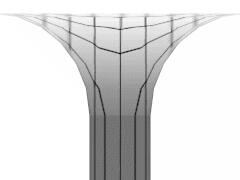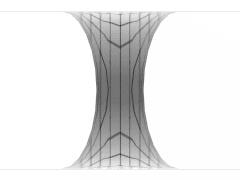|
|
||
| Chrono-Warp | Modern Physics | |
|
Main Links Contact About Us |
Now here is where the cool things begin. There are new theories emerging today that attempt to bring
Einstein's vision of the huge smooth universe, with quantum mechanic's vision of small quantized
packets. Currently we have a very good candidate for such a theory called the superstring theory, which
describes different particles as different vibrations of a very small string. Forces are caused by these
strings moving through space.   However, Einstein's predictions also predict that this rip through space must have another opening on the other side. This opening may be to another universe or to another part of our own universe. This is called a wormhole and it is illustrated below.   We are still not quite certain, but if we take advantage of wormholes, we can travel across the universe much faster than if we traveled at the speed of light. We are not violating relativity because we are still moving slower than the speed of light when passing through a wormhole. However, no one knows how you can go through a wormhole without being destroyed. In addition, the energy needed to create wormholes are approximately a quadrillion times the amount of energy that we can even produce. There is also another interesting thing about wormholes. If you can move through space, why not move through time as well? Well, even though this seems contradictory to many physicists, some say that it may be done. This is only a small peek of the interesting things going on in modern physics today. Source: ThinkQuest
|
|
| The Team | ||
|
Members Join |
||
| Information | ||
|
Sliders |
||
| The Lab | ||
| Misc. | ||
|
Banners Buttons Terminology Competition |
||
| Message Board | ||
| Go to the boards | ||
| Affiliates | ||
|
1. open 2. open 3. open 4. open 5. open |
||
